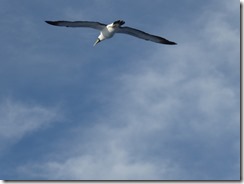April 9, 2018
We have had a series of lectures from Don Klein, as I mentioned before. With several more to come. Yesterday, Norm went to the lecture and I watched it on TV later and – wow – what a lot of facts we learned about the Amazon. We are really looking forward to the adventure.
Yesterday we crossed the equator. We have done it many times but we always go to the crossing ceremony where those who have never crossed are “initiated” and the ship is given permission from “King Neptune” to actually cross the equator. Here are some shots of the procession and the ceremony.
As you can see, there was a fish kissing involved and some pies in the face for 3 crew who had never crossed before.
We entered the Amazon this morning, and as I write this, we have dropped anchor and are awaiting the 2 pilots that will be on the ship for the entire week we are on the river, each taking 12 hour shifts on the bridge. We just watched two pilots board a cargo ship nearby. Ours have just arrived.
The first thing to say about the Amazon – it is BIG and the water is brown. Don Klein says that it may look dirty but it is not, you can drink it! Not that we will try.
The Amazon is the longest river in the world and here are some other things we learned:
- It varies between 1 and 35 miles wide. The peak height is in June, the most rainy month. We are in the beginning of the rainy season now.
- The Amazon basin is a huge rainforest and it is 80-85% still OK. But every year a part the size of Connecticut is lost.
- It provides 20% of all the earth’s flowing water and at the mouth of the river, it discharges 7,000,000 cubic feet of water PER SECOND. 4.5 trillion gallons. That is enough water to supply all the homes in the US for more than 5 months.
- The outflow would fill Lake Ontario in 3 months.
- It is made up of volcanic soil and water.
- The Amazon basin is mostly flat and is made up of 2.3 million square miles. The area covered by the Amazon river and its tributaries more than triples over the course of a year. In dry season 110,000 square km of land is water covered but in the wet season the flooded area rises to 350,000 square km. The difference in height of the river between dry and wet seasons is 90 feet.
- Marajo island at the mouth of the river is the largest fresh water island in the world and is the size of Massachusetts, Connecticut and Rhode Island combined.
- There is little deviation in rain, sun, and length of the day because of the harmony of nature here. There are no natural catastrophes, there is a uniform climate (average only 5 degrees F variation) and it is located on the equator.
- 1/2 of the world’s species of birds are found here as well as the largest parrots, otters and fish – the 350 pound pirancu. There are 2500 species of fish and over 500 different species of catfish (who knew!) some weigh 200 pounds.
- As a comparison, in every 2.5 acres there are 90 species of trees – over 500 trees. In temperate zones like where we live, the same area would contain 5-6 species and 90 trees.
- The river is 250-300 feet deep.
- We saw some pictures of moths that look like small plates – we might make that mistake if we eat in the Terrace Cafe while on the river!
- There is a pink dolphin species that is more fish than mammal – no dorsal fin. We hope to see them while here. The boto is another dolphin we hope to spot – it is the largest dolphin in the world.
- The big 3 to watch for are the Harpy Eagle, the jaguar and the anaconda. I don’t prefer the last 2!
- The coati we saw at Iguazu are also plentiful here and they are apparently as smart as 10 house cats. Many monkeys and 3 toes sloths live here too.
Here are some shots as we entered the river. It was a bit rainy as we went for our morning deck walk but soon stopped. You can see how big the river is and how brown but not much else at this point.
Tomorrow is our first stop, Santarem, from noon to 8 PM. Two of the stops have no organized tours, Boca Da Valeria and Alter Do Chao. We also have a stop in Manaus. Much more to say after each, I am sure.



















you will love the Amazon. We did it several years ago with Oceania. It is a very diverse country along the river and the stops you will make will reflect that.
LikeLike
Your info on the Amazon is terrific. Must be a truly spectacular sight. Also, I remember the Equator crossing from before. Great tradition!
LikeLike